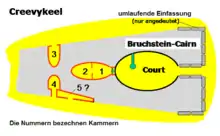Creevykeel Court Tomb
Creevykeel Court Tomb is one of the finest examples of a court tomb remaining in Ireland.[1] The monument is located in the N15 Donegal to Sligo road, 200 meters north of Creevykeel cross-roads close to Cliffoney village in County Sligo. The original name for the Creevykeel monument is Caiseal an Bhaoisgin, the Fort of Bhaoisgin, Tober an Bhaoisgin being the name of the well near the cairn.[2] A second megalithic monument existed 300 meters to the north, but it was demolished around 1890.[3]

The Monument
The building of the tomb dates back to the Neolithic Period, 4000-2500 BC, when waves of colonising farmers migrated to Ireland from the continent.[4] The Creevykeel Court Tomb is one of five megalithic monuments in the area. Creevykeel has not been dated using modern scientific methods, and is estimated to date from about 3,500 BC with a long span of use and re-use.
The monument consists of a long, trapezoid-shaped cairn of stones which measures 55 meters along its east - west axis, 25 meters at the wider eastern facade, and 10 meters wide at the western end or tail of the cairn. The stones used to construct the monument are a hard local sandstone with a bluish tint.[2]
The cairn encloses an oval-shaped full court 15 by 10 meters with an entrance passage through the cairn on the east side. The entrance to the main chamber is located at the centre of an imposing megalithic facade on the west side of the court. The chamber is made up of two large compartments divided by a pair of jambs which presumably supported an inner lintel like those at Shawley and Croaghbeg in County Donegal. Evidence of corbel slabs used for roofing the structure survives in the inner chamber. In the back of cairn there are three subsidiary chambers which are built into the body of the monument, which have been described as being small passage-graves. However they seem to be an original and probably later addition to the original monument.
Archaeology
Creevykeel is widely considered to be one of the finest and best-preserved examples of an Irish court tomb.[5]
Excavations in 1935
The Creevykeel Court Tomb was excavated from 25 July to 4 September in 1935 by the fourth Harvard Archaeological Mission, an American collaboration with the Irish Free State Government, which were the first modern scientific excavations to take place in Ireland. The director of the excavation was Hugh O'Neill Hencken, the Curator of European Archaeology at the Peabody Museum in Harvard. Twenty-seven workers were involved in the dig, many being local labourers hired under an innovative State employment scheme. [6]
The cairn material was removed entirely and then replaced again after the excavation had been completed, leaving the large megalithic boulders in their original positions. The excavators found that the large structural chunks of sandstone are resting on the old ground surface, rather than being placed in sockets. A section of cobbled and paved surface was found under the court, and evidence of large fires was uncovered.[2]
Finds
A large number of items from both the neolithic and early Christian periods were discovered.
Two polished stone axe heads were found, one buried between the jambs dividing the chamber; the other, a fine diorite example was found at the inner entrance of the court, again between two jambs. Other finds from the main chamber included a large flint knife, about 13 cm long, arrowheads, pot sherds, some quartz crystals, and flint scrapers.
Early Christian occupation
A smelting pit or blast furnace from the early Christian period was discovered east of and close to the entrance to the neolithic chamber. "Perhaps the most intriguing aspect of Creevykeel is the Early Christian construction found in the northwestern part of the court, built when the original Late Neolithic – Early Bronze Age cairn was long derelict."[7]
Discussion
The monument appears to have been built in at least three phases, with an open court facing to the east during phase one, with the entrance flanked by large megalithic blocks with a massive triangular lintel stone. Phase two saw the court enclosed to become a contained area. A new entrance was added on the east side of the court, which is not in line with the axis of the main chamber. During a third phase the cairn was lengthened and widened by as much as two meters on the sides and six meters at the eastern end. The old facade can still be seen as a line of boulders within the cairn.
The large lintel stone, which was found lying in the chamber, stood upright creating an imposing monumental facade. Hencken, did not believe the accounts of local residents, who told him the stone had stood upright until it was pushed over within living memory. He had the massive lintel stone lifted and placed horizontally over the door jambs in its current position in order to excavate the chamber.[2]
Gallery
References
- "Creevykeel home". Megalithicireland.com. Archived from the original on 26 April 2014. Retrieved 26 April 2014.
- O'Neill Hencken, Hugh (1939). LONG CAIRN AT CREEVYKEEL, CO. SLIGO. THE ROYAL SOCIETY OF ANTIQUARIES.
- Wood-Martin, W. G. (2015). The Rude Stone Monuments Of Ireland. Andesite Press. ISBN 978-1297523700.
- "Creevykeel Court Tomb, Co. Sligo - National Monuments Service". Archaeology.ie. Archived from the original on 27 April 2014. Retrieved 26 April 2014.
- Raftery, Joseph (1951). Prehistoric Ireland.
- Carew, Mairéad (2018). The Quest for the Irish Celt. Irish Academic Press. ISBN 978-1788550093.
- "CREEVYKEEL COURT TOMB". Voices From the Dawn. Retrieved 11 October 2020.
External links
- http://www.carrowkeel.com/creevykeel/ - Local site, www.creevykeel.com
- Voices from the Dawn at Creevykeel.
- http://www.megalithicireland.com/Creevykeel%20Court%20Tomb.html - Creevykeel Court Tomb


